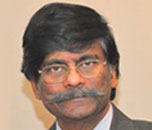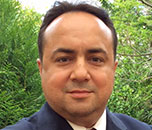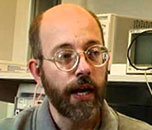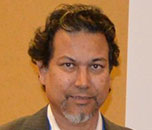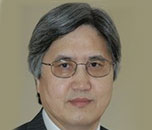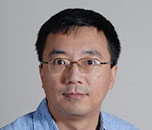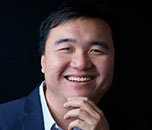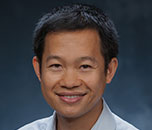Theme: Sensor Technologies in Biosensor Innovations
Biosensors and Bioelectronics 2016
Track 1: Biosensors
A biosensor is an analytical device, used for the detection of an analyte,that combines a biological component with a physicochemical detector. Electrochemical biosensors are normally based on enzymatic catalysis of a reaction that produces or consumes electrons (such enzymes are rightly called redox enzymes). The sensor substrate usually contains three electrodes; a reference electrode, a working electrode and a counter electrode. Amperometric biosensors function by the production of a current when a potential is applied between two electrodes. They generally have response times, dynamic ranges and sensitivities similar to the potentiometric biosensors. The potentiometric biosensor, (potential produced at zero current) gives a logarithmic response with a high dynamic range. Such biosensors are often made by screen printing the electrode patterns on a plastic substrate, coated with a conducting polymer and then some protein (enzyme or antibody) is attached. They have only two electrodes and are extremely sensitive and robust. A microbial biosensor is an analytical device which integrates microorganism(s) with a physical transducer to generate a measurable signal proportional to the concentration of analytes.
Track 2: Biosensors Applications
Graphene based enzymatic and non-enzymatic electrodes can efficiently detect glucose, cytochrome-c, NADH, hemoglobin, HRP, and cholesterol, hydrogen peroxide, AA, UA, DA, respectively. Nanocapsules are nanoscale shells made out of a nontoxic polymer. They are vesicular systems that are made up of a polymeric membrane which encapsulates an inner liquid core at the nanoscale level. Nanocapsules have a myriad of uses, which include promising medical applications for drug delivery, food enhancement, nutraceuticals, and for the self-healing of materials.
Track 3: DNA Chips and Nucleic acid Sensors
Aptamers are oligonucleotide or peptide molecules that bind to a specific target molecule. Aptamers are usually created by selecting them from a large random sequence pool, but natural aptamers also exist inriboswitches. Immunosensors are built by means of the appropriate combination of the biomolecules with the transducer used together, they can be applied in specific analytical situations. Immunosensors commonly rely on the reuse of the same receptor surface for many measurements. A Biochip is a combination of minute DNA spots hooked up to a hard surface. Scientists use DNA Biochips to check the expression levels of huge number of genes at the same time. Each DNA spot contains picomoles of a precised DNA sequence known as a probe. These can be tiny section of a gene or a DNA particle that are used to cross breed a cDNA or cRNA. Probe-target cross breeding is usually quantified and detected by detection of fluorophore. Silver or chemiluminescence-labeled targets to identify corresponding abundance of nucleic acid sequences in the target. Sensors are devices that respond to physical or chemical stimuli and produce detectable signals. They are a critical extension of human perception of the world in many aspects of the modern society. This is largely because we are much less sensitive to the chemical or biological environment than to the physical environment (e.g., light, pressure, temperature, or humidity). However, appropriate chemical or biological compositions are tightly linked to the quality of life.
Track 4: Bioelectronics
Biological properties can be measured and altered using electronics, magnetics, photonics, sensors, circuits, and algorithms. Applications range from basic biological science through clinical medicine, and enable new discoveries, diagnoses, and treatments by creating novel devices, systems, and analyses. Biomolecular Electronics is a branch of nano-science and technology dealing with the investigation and the technological exploitation of electron transport properties in special classes of biomolecules. Albeit it deals with molecules that can donate to or receive electrons, biomolecular electronics has nothing to do with the molecular bases ruling the generation and propagation of electrical signals in neural cells, i.e. the action potential. Bioanalysis is one of the sub categories of Chemistry that helps in measuring Xenobiotics (unnatural concentration or location of drugs, Metabolites and biological molecules) in biological system. Biomedicine is a branch of medical sciences that deals with applying biological and natural science principles to clinical practices. It studies our ability to cope with the environmental changes.
Track 5: Photonic sensor technologies
Optical fibers can be used as sensors to measure strain, temperature, pressure and other quantities by modifying a fiber so that the quantity to be measured modulates the intensity, phase, polarization, wavelength or transit time of light in the fiber. Sensors that vary the intensity of light are the simplest, since only a simple source and detector are required. A particularly useful feature of intrinsic fiber optic sensors is that they can, if required, provide distributed sensing over very large distances. Photonic integrated circuits (PICs) are optically active integrated semiconductor photonic devices which consist of at least two different functional blocks, (gain region and a grating based mirror in a laser...). These devices are responsible for commercial successes of optical communications and the ability to increase the available bandwidth without significant cost increases to the end user, through improved performance and cost reduction that they provide. The most widely deployed PICs are based on Indium phosphide material system. Silicon photonics is an active area of research.
Track 6: Biosensing Technology
Biomechanics is closely related to engineering, because it often uses traditional engineering sciences to analyze biological systems. Some simple applications of Newtonian mechanics and/or materials sciences can supply correct approximations to the mechanics of many biological systems. Reliable methodologies are needed for point and stand-off detection of chemical, biological, radiological, special nuclear and explosive (CBRNE) materials. These technological needs are not universally military in nature. For example, there is pervasive interest among diverse disciplines such as medicine, law enforcement, explosive ordinance disposal, environmental protection, industrial manufacturing and food processing in being able to develop capabilities for the rapid detection and identification capabilities for various chemical markers.
Track 7: Biosensors for Imaging
The field of optical sensors has been a growing research area over the last three decades. A wide range of books and review articles has been published by experts in the field who have highlighted the advantages of optical sensing over other transduction methods. Fluorescence is by far the method most often applied and comes in a variety of schemes. Nowadays, one of the most common approaches in the field of optical biosensors is to combine the high sensitivity of fluorescence detection in combination with the high selectivity provided by ligand-binding proteins. In this chapter we deal with reviewing our recent results on the implementation of fluorescence-based sensors for monitoring environmentally hazardous gas molecules. Medical Image Analysis provides a forum for the dissemination of new research results in the field of medical and biological image analysis, with special emphasis on efforts related to the applications of computer vision, virtual reality and robotics to biomedical imaging problems.
Track 8: Environmental Biosensors
Biosensors are biophysical devices which can detect the presence of specific substances e.g. sugars, proteins, hormones, pollutants and a variety of toxins in the environment. They are also capable of measuring the quantities of these specific substances in the environment.
Track 9: Bioinstrumentation
Biomedical engineering (BME) is the application of engineering principles and design concepts to medicine and biology for healthcare purposes (e.g. diagnostic or therapeutic). This field seeks to close the gap between engineering and medicine: It combines the design and problem solving skills of engineering with medical and biological sciences to advance health care treatment, including diagnosis, monitoring, and therapy. To ensure that good quality assurance practices are used for the design of medical devices and that they are consistent with quality system requirements worldwide, the Food and Drug Administration revised the Current Good Manufacturing Practice (CGMP) requirements by incorporating them into the Quality System Regulation, 21 CFR Part 820. An important component of the revision is the addition of design controls.
Track 10: Advancement in Nanotechnology
Nanolithography is the art and science of etching, writing, or printing at the microscopic level, where the dimensions of characters are on the order of nanometers (units of 10 -9meter, or millionths of a millimeter). This includes various methods of modifying semiconductor chips at the atom ic level for the purpose of fabricating integrated circuits. Nanophotonics is the new emerging paradigm where light interacts with nano-scaled structures and brings forth the mysterious world to research.The combination of Photonics and Nanotechnology giving birth to “Nanophotonics” compliments and benefits each other in terms of new functions, materials, fabrication processes and applications.
Track 11: BioMEMS/NEMS
Bionics is the application of biological methods and systems found in nature to the study and design of engineering systems and modern technology Bionics means the replacement or enhancement of organs or other body parts by mechanical versions. Bionic implants differ from mere prostheses by mimicking the original function very closely, or even surpassing it. Biorobotics is the use of biological characteristics in living organisms as the knowledge base for developing new robot designs. The term can also refer to the use of biological specimens as functional robot components. Biorobotics intersects the fields of cybernetics, bionics, biology, physiology, and genetic engineering.
Track 12: Transducers in Biosensors
A biotransducer is the recognition-transduction component of a biosensor system. It consists of two intimately coupled parts; a bio-recognition layer and a physicochemical transducer, which acting together converts a biochemical signal to an electronic or optical signal. Electronic biosensing offers significant advantages over optical, biochemical and biophysical methods, in terms of high sensitivity and new sensing mechanisms, high spatial resolution for localized detection, facile integration with standard wafer-scale semiconductor processing and label-free, real-time detection in a nondestructive manner. Gravimetric biosensors use the basic principle of a response to a change in mass. Most gravimetric biosensors use thin piezoelectric quartz crystals, either as resonating crystals (QCM), or as bulk/surface acoustic wave (SAW) devices. Pyroelectric biosensors generate an electric current as a result of a temperature change. This differential induces a polarization in the substance, producing a dipole moment in the direction of the temperature gradient. The result is a net voltage across the material.
It is a great pleasure and an honor to extend you a warm invitation to attend 6th International Conference and Exhibition on Biosensors & Bioelectronics to be held in September 22-24, 2016 at Phoenix, USA.
Biosensors & Bioelectronics conference is conducted annually. Building on the achievement of the earlier conferences being held in Chicago (2013) followed by in San Antonio (2014) and in Atlanta (2015), OMICS International delightfully welcomes once again all the researchers and developers to share their experiences and ideas through research talks and presentations from diverse fields in advanced sensor technology. This event offered a platform in bringing together a forum for students, postdocs and established scientists to exchange their ideas and contributing an integrative approach to Biosensors & Bioelectronics Research. It provides a forum for accessing to the most up-to-date and reliable knowledge from both commercial and academic worlds, sharing best practice in the field as well as learning about case studies of successfully integrated bio-sensing technologies. The meeting also provides an opportunity to highlight the recent developments besides identifying emerging future areas of growth.
Biosensors & Bioelectronics-2016 conference explores new advances and recent updated technologies. It is your high eminence that you enhance your research work in this field. Biosensors conference deals with recent advances in the field of biosensors like security and sensing, photonic sensor technologies, Biosensors for imaging and many more. Biosensors congress provides a unique platform for people who conduct their research work in this field. The conference captivates individuals both from commercial and academic worlds yet establishes a firm link and binds us together with the recent updated accomplishments. We provide a good opportunity by admiring your updated research knowledge and also by publishing it in our respective OMICS Group Journals. The congress ultimately provides a good gathering of bright personalities to update us the recent knowledge on Biosensors.
Importance and Scope:
Biosensors and Bioelectronics-2016 provides a unique forum for the publication of innovative research on the development of alternative sustainable technologies. Biosensors which provide monitoring biological and synthetic processes can be used besides medical measuring and analyzing, for environmental observations and controls, defense industry, agriculture and food. Thus, they have an important role in daily life. In this review, characteristics of biosensors that are used in medical measuring and analyzing have been determined and classiï¬cations of biosensors according different features that are found in literature are presented.
The forum of Scientists, students and researchers from all corners of the globe, come together to discuss future science. Each session of the meeting will be included with expert lectures, poster and discussions, join us to design sustainable processes, innovations by which and how these strategies drive new policies, advances the business and human health protection. We are glad to invite you on behalf of organizing committee to join us, where you are the decision maker for future.
Why to attend?
Meet Your Target MarketWith three days of programming, the Biosensors and Bioelectronics-2016 conference features 64 technical sessions, a poster session and keynotes lectures. This conference invites scientists, decision-makers, Post Docs and students to come together, compare findings, and discuss the future sciences. Share your research with an engaged audience of your peers from around the globe; learn from scientific trailblazers who are designing more sustainable sensors and processes; find out how Biosensors and Bioelectronics inspires new business and product lines.
Target Audience:
Nobel laureates & MD/Presidents, Vice Presidents, Departmental Head & Chairs. Vendors will have the opportunity to introduce the Sensor technologies to a diverse audience by becoming a conference sponsor via exhibits and/or workshops.
For more Details please click here
Biosensors Market Growing Exponentially, Will Reach $21.17 Billion By 2020: Latest Report By Grand View Research, Inc.
Global biosensors market is expected to reach USD 21.17 billion by 2020, according to a new study published by Grand View Research, Inc. Biosensors, owing to their capability to resolve various analytical issues in diverse areas such as medicine, pharmacology, food & agriculture safety and defense, are expected to witness a rapid growth in demand over the next six years. Increasing demand for specific detection techniques for early diagnosis in the healthcare sector is expected to drive the overall biosensors market during the forecast period. Furthermore, the expanding role of biosensors in the real world environment has led to a hike in R&D efforts globally.
Further key findings from the study suggest:
Optical biosensors are identified as the most lucrative technology segment of this market and are expected to grow at a CAGR of over 7.0% during the forecast period. Growing use of these sensors in the field of environmental scanning is one of the key drivers of this market. The recent progress in optical biosensors has made them apt for environmental scanning wherein they are used for quantifying and characterizing environmental pollutants. Biosensors are mostly used in devices enabled with point of care testing. The biosensors based point of care testing segment accounted for over 40% of the end-use market in 2013. Moreover, rising demand for portable and integrated technologies that can be operated by untrained personnel outside conventional laboratories is expected to improve usage rates. North America accounted for more than 35% of the market in 2013. Biosensors witness the highest market penetration rates in this region owing to the presence of high procedure volumes supported by favorable government initiatives. Moreover, rapidly growing demand for point of care and home healthcare markets in the U.S. is expected to drive regional market growth during the forecast period. Asia Pacific has high future growth potential owing to the presence of large untapped opportunities in the emerging markets of India and China. Presence of favorable government initiatives aimed at improving environmental conditions and enhancing healthcare infrastructure in Japan and Australia are also expected to serve as a high impact rendering driver for this market.
Key players of this market include Abbott Point of Care Inc., Roche, Lifescan Inc., Bayer AG, Medtronic Inc., Universal Biosensors, Siemens Healthcare and Nova Biomedical Corporation.
For the purpose of this study, Grand View Research has segmented the global biosensors market on the basis of application, technology and end-use:
Global Biosensors Application Outlook (Market Revenue in USD Million, 2012 – 2020)
Medical Applications, Cholesterol Testing, Blood Glucose Monitoring, Blood Gas Analyzer, Pregnancy Testing, Drug Discovery, Infectious Diseases, Food Toxicity Detection, Industrial Process Control (Bioreactor), Agriculture, Environment and Others
Global Biosensors Technology Outlook (Market Revenue in USD Million, 2012 – 2020)
Thermal Biosensors, Electrochemical Biosensors, Piezoelectric Biosensors, Optical Biosensors
Global Biosensors End-use Outlook (Market Revenue in USD Million, 2012 – 2020)
Home Healthcare Diagnostics, Point of Care Testing, Food Industry, Research Laboratories,Security and Bio-Defense
Biosensors Regional Outlook (Market Revenue in USD Million, 2012 – 2020)
North America, USA, Canada, Europe, UK, Spain, Germany, Asia Pacific, India, China, Japan, RoW
Conference Highlights
To share your views and research, please click here to register for the Conference.
To Collaborate Scientific Professionals around the World
| Conference Date | September 22-23, 2016 | ||
| Sponsors & Exhibitors |
|
||
| Speaker Opportunity Closed | Day 1 | Day 2 | Day 3 |
| Poster Opportunity Closed | Click Here to View | ||
Useful Links
Special Issues
All accepted abstracts will be published in respective Our International Journals.
- Journal of Biosensors & Bioelectronics
- Journal of Bioengineering & Biomedical Science
- Journal of Biotechnology & Biomaterials
Abstracts will be provided with Digital Object Identifier by












